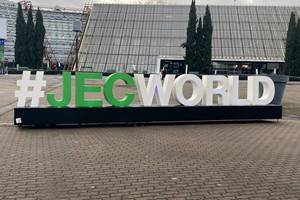Carver Non-Woven Technologies opens its doors
US-based Carver Non-Woven Technologies offers nonwovens made with glass fiber, bast, carbon fiber, basalt fiber and thermoplastic fibers in densities ranging from 300-2,400 gsm.
Carver Non-Woven Technologies LLC (Fremont, Ind.), a wholly owned subsidiary of custom compression molder and compounder, (Grabill, Ind.), will begin a rolling startup at its new manufacturing facility on July 1, and by July 15 will be in full commercial production of high-quality, single- and multi-material nonwoven products for R3 and the broader North American composites industry. The new plant is situated on an 18-acre property in a 15,329m2 building.
Carver says it is unique in how it approaches many aspects of the design and production of nonwovens. First, the company's complete production line is fully automated ― from initial debaling, fiber opening, blending, and carding, all the way through to finished packaging. As a result, Carver is able to produce nonwovens with low-variance weight (density) as well as whas is said to be superior dimensional stability and mechanical properties. This reportedly leads to nonwovens that are more consistent and mechanically more efficient (meaning a lower density nonwoven can be used in a given composite part without sacrificing tolerances or mass). This, in turn, can have the follow-on benefits of reducing cost and mass of finished applications in either thermoset or thermoplastic composites. Furthermore, Carver uses up to three opening processes during initial fiber handling, which leads to better, more open fibers and more consistent fiber length (owing to less fiber damage), as well as a more homogeneous fiber architecture in the finished composite part.
Fiber types Carver works with include E-glass fiber, bast natural fiber, carbon fiber, basalt fiber and thermoplastic fiber, including virgin and 100% recycled polyethylene terephthalate (PET), polyamide (PA), polypropylene (PP), polylactic acid (PLA), as well as high-density and low-density polyethylene (HDPE and LDPE). Carver also is one of the first to offer carbon fiber needled nonwovens in a multitude of blends at considerably lower costs than with conventional wrap-and-resonate processes.
During nonwovens production, fleece mats are typically coated with thermoset binder resins, including an acrylic/latex binder, which itself confers unique properties including specific colorants when the mats are subsequently impregnated with thermoset resins prior to forming. Carver's dual-web configuration enables the company to formulate products using different binder types, including the novel option to combine two different resin formulations in a single-fiber architecture. Areal weights range from 300-2,400 gsm using numerous fiber types, blends and layering.
The new production facility features what Carver says are state-of-the-art technologies, including the latest developments in fiber opening, blending, carding, cross-lapping and web drafting, web scanning, and needling. Carver also has negotiated supply agreements (covering fiber specifications and quality as well as purchase price) with its entire supply chain for all fiber types, but especially with suppliers of bast (natural) fibers in Southeast Asia.
"We're very proud of the amount of flexibility, new technology, and custom-modified equipment this new facility represents," notes Mark Glidden, president, R3 Composites and Carver Non-Woven. "To achieve this level of competence right from the start, our organization has made a substantial $13- million dollar [USD] investment. If our products really take off the way we believe they will, then our five-year plan calls for us to make an additional $20-million dollar investment to expand our operations. Others may say that sounds overly confident, but I can share that for the first time in 35 years of doing business, our company has a letter of intention from an automotive OEM stating that as soon as we're operational, this company will buy 3 million square meters of product per year from us. We have similar letters of intent from tier suppliers for the RV [recreational vehicle] industry. We are well on our way to filling our capacity for the first phase of our line, and we've just opened the doors."
Related Content
JEC World 2024 highlights: Glass fiber recycling, biocomposites and more
CW technical editor Hannah Mason discusses trends seen at this year’s JEC World trade show, including sustainability-focused technologies and commitments, the Paris Olympics amongst other topics.
Read MoreSMC composites progress BinC solar electric vehicles
In an interview with one of Aptera’s co-founders, CW sheds light on the inspiration behind the crowd-funded solar electric vehicle, its body in carbon (BinC) and how composite materials are playing a role in its design.
Read MoreASCEND program completion: Transforming the U.K.'s high-rate composites manufacturing capability
GKN Aerospace, McLaren Automotive and U.K. partners chart the final chapter of the 4-year, £39.6 million ASCEND program, which accomplished significant progress in high-rate production, Industry 4.0 and sustainable composites manufacturing.
Read MoreThermoplastic composites: Cracking the horizontal body panel nut
Versatile sandwich panel technology solves decades-long exterior automotive challenge.
Read MoreRead Next
Ultrasonic welding for in-space manufacturing of CFRTP
Agile Ultrasonics and NASA trial robotic-compatible carbon fiber-reinforced thermoplastic ultrasonic welding technology for space structures.
Read MoreCutting 100 pounds, certification time for the X-59 nose cone
Swift Engineering used HyperX software to remove 100 pounds from 38-foot graphite/epoxy cored nose cone for X-59 supersonic aircraft.
Read MoreCeramic matrix composites: Faster, cheaper, higher temperature
New players proliferate, increasing CMC materials and manufacturing capacity, novel processes and automation to meet demand for higher part volumes and performance.
Read More












